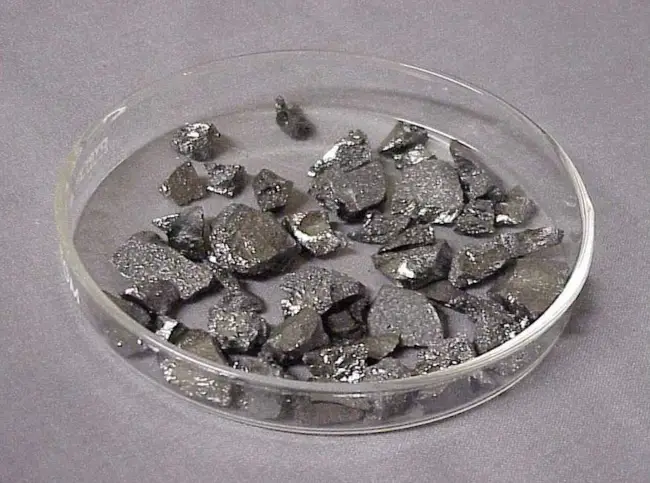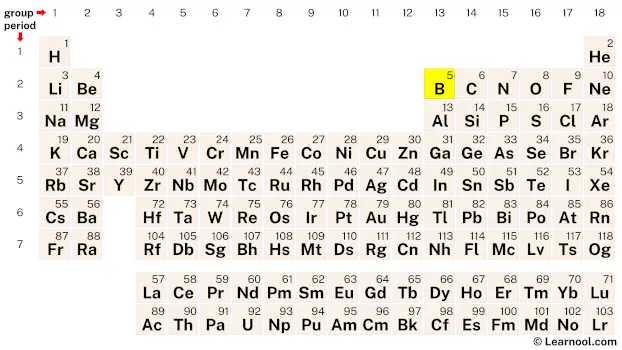
Boron (B) is a chemical element of the periodic table, located in the group 13 and the period 2, and is having the atomic number 5. It is a dark, lustrous, black-brown metalloid, whose name comes from the Arabic word “buraq”, which means the mineral borax. It is the first element in the boron group and is the lightest element of the boron group.
On periodic table
| group | ⇨ | 1 | 2 | 3 | 4 | 5 | 6 | 7 | 8 | 9 | 10 | 11 | 12 | 13 | 14 | 15 | 16 | 17 | 18 |
| period | ⇩ | ||||||||||||||||||
| 1 | 1 H  Hydrogen |
2 He  Helium |
|||||||||||||||||
| 2 | 3 Li  Lithium |
4 Be  Beryllium |
5 B Boron |
6 C  Carbon |
7 N  Nitrogen |
8 O  Oxygen |
9 F  Fluorine |
10 Ne  Neon |
|||||||||||
| 3 | 11 Na  Sodium |
12 Mg  Magnesium |
13 Al  Aluminium |
14 Si Silicon |
15 P  Phosphorus |
16 S  Sulfur |
17 Cl  Chlorine |
18 Ar  Argon |
|||||||||||
| 4 | 19 K  Potassium |
20 Ca  Calcium |
21 Sc  Scandium |
22 Ti  Titanium |
23 V  Vanadium |
24 Cr  Chromium |
25 Mn  Manganese |
26 Fe  Iron |
27 Co  Cobalt |
28 Ni  Nickel |
29 Cu  Copper |
30 Zn  Zinc |
31 Ga  Gallium |
32 Ge  Germanium |
33 As  Arsenic |
34 Se  Selenium |
35 Br  Bromine |
36 Kr  Krypton |
|
| 5 | 37 Rb  Rubidium |
38 Sr  Strontium |
39 Y  Yttrium |
40 Zr  Zirconium |
41 Nb  Niobium |
42 Mo  Molybdenum |
43 Tc  Technetium |
44 Ru  Ruthenium |
45 Rh  Rhodium |
46 Pd  Palladium |
47 Ag  Silver |
48 Cd  Cadmium |
49 In  Indium |
50 Sn  Tin |
51 Sb  Antimony |
52 Te  Tellurium |
53 I  Iodine |
54 Xe  Xenon |
|
| 6 | 55 Cs  Caesium |
56 Ba  Barium |
72 Hf  Hafnium |
73 Ta  Tantalum |
74 W  Tungsten |
75 Re  Rhenium |
76 Os  Osmium |
77 Ir  Iridium |
78 Pt  Platinum |
79 Au  Gold |
80 Hg  Mercury |
81 Tl  Thallium |
82 Pb  Lead |
83 Bi  Bismuth |
84 Po  Polonium |
85 At  Astatine |
86 Rn  Radon |
||
| 7 | 87 Fr  Francium |
88 Ra  Radium |
104 Rf  Rutherfordium |
105 Db  Dubnium |
106 Sg  Seaborgium |
107 Bh  Bohrium |
108 Hs  Hassium |
109 Mt  Meitnerium |
110 Ds  Darmstadtium |
111 Rg  Roentgenium |
112 Cn  Copernicium |
113 Nh  Nihonium |
114 Fl  Flerovium |
115 Mc  Moscovium |
116 Lv  Livermorium |
117 Ts  Tennessine |
118 Og  Oganesson |
||
| 57 La  Lanthanum |
58 Ce  Cerium |
59 Pr  Praseodymium |
60 Nd  Neodymium |
61 Pm  Promethium |
62 Sm  Samarium |
63 Eu  Europium |
64 Gd  Gadolinium |
65 Tb  Terbium |
66 Dy  Dysprosium |
67 Ho  Holmium |
68 Er  Erbium |
69 Tm  Thulium |
70 Yb  Ytterbium |
71 Lu  Lutetium |
|||||
| 89 Ac  Actinium |
90 Th  Thorium |
91 Pa  Protactinium |
92 U  Uranium |
93 Np  Neptunium |
94 Pu  Plutonium |
95 Am  Americium |
96 Cm  Curium |
97 Bk  Berkelium |
98 Cf  Californium |
99 Es  Einsteinium |
100 Fm  Fermium |
101 Md  Mendelevium |
102 No  Nobelium |
103 Lr  Lawrencium |
|||||
| – p block |
Boron is a p-block element, situated in the thirteenth column of the periodic table, first member of the boron group. It has the atomic number 5 and is denoted by the symbol B.
Element information
 |
|
 |
|
| Origin of name | Arabic word “buraq” (which means mineral borax) |
| Symbol | B |
| Atomic number (Z) | 5 |
| Atomic mass | 10.811 u |
| Block | p-block |
| Group | 13 (boron group) |
| Period | 2 |
| Classification | Metalloid |
| Atomic radius | 90 pm |
| Covalent radius | 84±3 pm |
| Van der Waals radius | 192 pm |
| Melting point | 2076 ℃, 3769 ℉, 2349 K |
| Boiling point | 3927 ℃, 7101 ℉, 4200 K |
| Electron configuration | [He] 2s2 2p1 |
| Electrons per shell | 2, 3 |
| Learn how to draw: Boron Bohr model | |
| Crystal structure | Rhombohedral |
| Phase at r.t | Solid |
| Density near r.t | 2.3 g/cm3 |
| Main isotopes | Boron-10, Boron-11 |
| Natural occurrence | Primordial |
| Oxidation state | +3 |
| Electronegativity (Pauling scale) | 2.04 |
| Protons Neutrons Electrons |
5 6 5 |
| Learn how to find: Boron protons neutrons electrons | |
| Valence electrons | 3 |
| Learn how to find: Boron valence electrons | |
| CAS number | 7440-42-8 |
| Discovered by | Joseph Louis Gay-Lussac and Louis Jacques Thénard on 30 June 1808 |
History
The history of boron dates back to ancient times, where it was used in various forms such as borax, a sodium borate mineral, by civilizations in Egypt, China, and the Middle East. However, it wasn’t until the early 1800s that boron was first isolated and identified as an element by French chemists Joseph-Louis Gay-Lussac and Louis-Jacques Thénard. In 1892, American chemist and physicist, Alfred Stock, prepared crystalline boron by reducing boron trichloride with hydrogen.
The first large-scale production of elemental boron was accomplished in 1909 by American chemist Ezekiel Weintraub, who heated boron oxide with magnesium powder. Since then, the production of boron has evolved and various methods are now employed including the reduction of boron halides with hydrogen or metal hydrides, and the thermal decomposition of boron-containing compounds.
Occurrence and production
Boron is relatively rare in the Earth’s crust, making up only about 0.001% of the Earth’s crust by weight. It occurs naturally in the form of borates, such as borax, kernite, and ulexite. Boron also occurs in various minerals such as boracite and colemanite. It can also be found in volcanic spring waters and seawater.
The production of elemental boron is primarily accomplished by the reduction of boron oxide with either magnesium or aluminum metal. The reduction process is typically conducted at high temperatures (1100-1300 ℃) and is carried out under a protective atmosphere of an inert gas such as argon. The process typically yields a mixture of boron and the metal used for the reduction, which is subsequently separated through a series of chemical reactions. Another common method of producing boron is through the thermal decomposition of boron halides such as boron trichloride. This process also requires high temperatures and a protective atmosphere of an inert gas.
Properties
Boron is a metalloid with the symbol B and atomic number 5.
It has a high melting point of 2076 ℃ and a boiling point of 3927 ℃.
Boron is a very hard substance and is used to make abrasives and cutting tools.
It is an excellent conductor of heat and is used in nuclear reactors as a neutron absorber.
Boron has a low density of 2.3 g/cm3 and is used in composites to strengthen materials such as carbon fibers and ceramics.
It has a unique ability to form strong covalent bonds and is used in the production of borosilicate glass, which has a low coefficient of thermal expansion and is resistant to thermal shock.
Boron is a semiconductor and is used in electronic devices such as transistors and diodes.
It has a low abundance in the Earth’s crust and is primarily found in borate minerals such as borax and kernite. It can also be obtained from seawater, coal, and shale gas.
Boron exists in various allotropes, including amorphous boron, crystalline boron, and boron nanotubes, which have unique properties and potential applications in various fields.
Applications
Boron is used as a control rod in nuclear reactors due to its ability to absorb neutrons and regulate the reaction.
Boron is used as a component in ceramics, particularly in heat-resistant materials due to its high melting point and thermal conductivity.
Boron is used to produce glass, particularly in the manufacture of heat-resistant glass such as Pyrex, due to its high resistance to thermal shock and chemical corrosion.
Boron is an essential nutrient for plant growth, and is used as a fertilizer in agriculture to improve crop yields.
Boron is used in the production of semiconductors and electronic components, particularly in the manufacture of diodes and transistors.
Boron is used in the aerospace industry, particularly in the construction of spacecraft and missiles due to its high strength and lightweight. It is also used as a fuel additive to increase the energy content of jet fuel.
Boron compounds are being studied for their potential in cancer treatment, as they have been shown to selectively target cancer cells while sparing healthy cells.
Interesting facts
Boron is the only metalloid in group 13 of the periodic table.
It has the highest strength-to-weight ratio of any metalloid element, making it useful for lightweight construction materials.
Boron fibers are used in the aerospace industry for their strength and resistance to heat.
Boron is used in pyrotechnics to create a bright green color in fireworks.
Boron has been found in biological systems, such as in the cell walls of some plants.
Boron is an essential micronutrient for plants and may have health benefits for humans when consumed in small amounts.
Boron is a semiconductor material and has potential applications in electronics.
Boron carbide is one of the hardest known materials and is used in armor and cutting tools.
Boron nitride has a similar structure to carbon nanotubes and has potential applications in nanotechnology.
Related
More elements
External links
- https://www.rsc.org/periodic-table/element/5/boron
- https://en.wikipedia.org/wiki/Boron
- https://www.britannica.com/science/boron-chemical-element
- https://pubchem.ncbi.nlm.nih.gov/element/Boron
- https://education.jlab.org/itselemental/ele005.html
- https://www.chemicool.com/elements/boron.html
- https://www.radiochemistry.org/periodictable/elements/5.html
- https://chemistrytalk.org/boron-element/
Deep
Learnool.com was founded by Deep Rana, who is a mechanical engineer by profession and a blogger by passion. He has a good conceptual knowledge on different educational topics and he provides the same on this website. He loves to learn something new everyday and believes that the best utilization of free time is developing a new skill.
